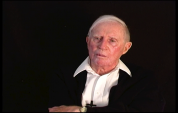3:54 | Bill Minor discusses his assignment to Task Force 58 and their initial days entering the Pacific Theater to fight the Japanese. His destroyer was responsible for defending the fleet’s air craft carriers while they provided air support for Marines landing on the islands.
Keywords : Task Force 58 Marc Mitscher aircraft carrier Pearl Harbor Marshall Islands

Before the war, Bill Minor was seeking a degree in Journalism at Tulane and was a member of one of the few Naval ROTC programs in the country. When the war broke out, things became gravely serious and he and others knew they were on their way to fight as commissioned officers.
During his time in ROTC before the war, Bill Minor had an exercise that took him up to New York City. Being a small town guy from rural Louisiana, he was blown away by the size and scope of the city, and got to see some musical legends during his brief time there; a highlight of his youth.
While Bill Minor was operating in the Pacific, they had to worry about not only the threats from above but also the threats down below. Japanese submarines were patrolling all over, and he recalls one instance where they encountered one.
Captain Crichton told the men to prepare for the worst, and through some miracle Bill Minor didn’t have to suffer through a direct hit from a torpedo. Sadly, the USS Intrepid wasn’t as fortunate.
The USS Stephen Potter played a pivotal role in defending the American fleet from Japanese aircraft. Bill Minor was below deck helping direct fire, and the development and implementation of a proximity fuse enhanced his ability to counter the threat in the skies.
Navy Seamen during the war would often be at sea for months at a time, and to sustain their presence in the Pacific they would need a steady supply of fuel. During a refueling stop, Bill Minor’s fleet was hit by a devastating typhoon which claimed the lives of hundreds of seamen.
Bill Minor recalls the few luxuries that could be afforded at sea, and with the USS Bunker Hill nearby they were sometimes lucky enough to get some ice cream. However, the aircraft carrier would be the target of two kamikazes and the USS Stephen Potter would take as many survivors as they could.
Not a lot of ships were lucky enough to have a mascot, but the USS Steven Potter had a beloved canine, Potts, to keep morale up.
Transferring people across ships at sea was made simple with the implantation of a breeches buoy. Bill Minor recalls when Admiral McCain was on board ship and refused to remove his lifejacket while they were delivering him to his next destination.